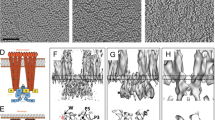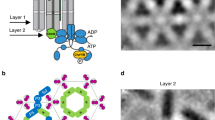Abstract
Bacterial adaptation to the environment is accomplished through the coordinated activation of specific sensory receptors and signal processing proteins. Among the best characterized of these pathways are those which employ the two-component paradigm. In these systems, signal transmission is mediated by Mg2+-dependent phospho-relay reactions between histidine auto-kinases and phosphoaccepting receiver domains in response-regulator proteins. Although this mechanism of activation is common to all response-regulators, detrimental cross-talk between different two-component pathways within the same cell is minimized through the use of specific recognition domains. Here, we report the crystal structure, at 2.95 Å resolution, of the response regulator of bacterial chemotaxis, CheY, bound to the recognition domain from its cognate histidine kinase, CheA. The structure suggests that molecular recognition, in this low affinity complex (KD = 2 μM), may also contribute to the mechanism of CheY activation.
This is a preview of subscription content, access via your institution
Access options
Subscribe to this journal
Receive 12 print issues and online access
$189.00 per year
only $15.75 per issue
Buy this article
- Purchase on Springer Link
- Instant access to full article PDF
Prices may be subject to local taxes which are calculated during checkout
Similar content being viewed by others
References
Swanson, R.V., Schuster, S.C. & Simon, M.I. Biochemistry, 32, 7623–7629 (1993).
Morrison, T.B. & Parkinson, J.S. Proc. Nat. Acad. Sci. USA 91, 5485–5489 (1994).
Zhou, H., McEvoy, M.M., Swanson, R.V., Simon, M.I. & Dahlquist, F.W. Biochemistry 35, 433–443 (1996).
Zhou, H., Lowry, D.F., Swanson, R.V., Simon, M.I. & Dahlquist, F.W. Biochemistry 34, 13858–13870 (1995).
McEvoy, M.M. et al. Biolchemistry 34, 13871–13880 (1995).
Surette, M.G. et al. J. Biol. Chem. 271, 939–945 (1996).
Levit, M., Liu, Y., Surette, M. & Stock, J. J. Biol. Chem. 271, 32057–32063 (1996).
McEvoy, M.M., de la Cruz, A.F.A. & Dahlquist, F.W. Nature Struct. Biol. 4, 9 (1997).
McEvoy, M.M., Muhandiram, D.R., Kay, L.E. & Dahlquist, F.W. Biochemistry 35, 5633–5640 (1996).
Chothia, C., Janin, J. Nature 256, 705–708 (1975).
Li, J., Swanson, R.V., Simon, M.I. & Weis, R.M. Biochemistry 34, 14626–14636 (1995).
Swanson, R.V. et al. Nature Struct. Biol. 2, 906–910 (1995).
Volz, K. Biochemistry 32, 11741–11753 (1993).
Stock, J.B., Ninfa, A.J. & Stock, A.M. Microbiol. Rev. 53, 450–490 (1989).
Parkinson, J.S. & Kofoid, E.C. Annu. Rev. Genet. 26, 71–112 (1992).
Bischoff, D.S., Bourret, R.B., Kirsch, M.L. & Ordal, G.W. Biochemistry 32, 9256–9261 (1993).
Kuo, S.C. & Koshland, D.E. Jr. J. Bact. 169, 1307–1314 (1987).
Volz, K. & Matsumura, P. J Biol Chem 266, 15511–15519 (1991).
Stock, A.M. et al. Biochemistry 32, 13375–13380 (19
Moy, F.J. et al. Biochemistry 33, 10731–10742 (1994).
Ganguli, S., Wang, H., Matsumura, P. & Volz, K. J. Biol. Chem. 270, 17386–17393 (1995).
Zhu, X., Rebello, J., Matsumura, P. & Voltz, K. J. Biol. Chem. 272, 5000–5006 (1997).
Shukla, D. & Matsumura, P. J. Biol. Chem. 270, 24414–24419 (1995).
Garzon, A. & Parkinson, J.S. J. Bact. 178, 6752–6758 (1996).
Amsler, C.D. & Matsumura, P. Chemotactic signal transduction in Escherischia coli and Salmonella typhimurium in Two-component signal transduction (eds Hoch, J. A. & Silhavy, T. J.) 89–99 (American Society for Microbiology, Washington, DC-20005; 1995).
Leslie, A.G.W. in Computational Aspects of Protein Crystal Data Analysis, Proceedings of the Daresbury Study Weekend (eds Helliwell, J.R., Machin, P.A. & Papiz, M.Z.) 39–50 (SERC, Daresbury Laboratory, Warrington,UK; 1987).
Collaborative Computational Project 4. Acta Crystallagr. D 50, 760–763 (1994).
La Fortelle, E. de & Bricogne, G. Maximum-Likelihood Heavy-Atom Parameter Refinement in the MIR and MAD Methods in Methods in Enzymology, Macromolecular Crystallography, Vol. 276 (eds Sweet, R.M. & Carter, C. W. Jr.) 472–494 (Academic Press New York; 1997).
Cowtan, K. ‘DM’ an automated procedure for phase improvement by density modification. Joint CCP4 and ESF-EACBM Newsletter on Protein Crystallography, Vol. 31 (eds Bailey, S. & Wilson, K.) 34–38 (Daresbury Laboratory, Hamburg,–Germany; 1994).
Navaza, J. Acta Crystallogr. A 50, 157–163 (1994).
Brünger, A.T. X-PLOR Version 3.1: A System for X-ray Crystallography and NMR (Yale University Press, New Haven, CT; 1992).
Brünger, A.T. Nature 355, 472–475 (1992).
Author information
Authors and Affiliations
Corresponding author
Rights and permissions
About this article
Cite this article
Welch, M., Chinardet, N., Mourey, L. et al. Structure of the CheY-binding domain of histidine kinase CheA in complex with CheY. Nat Struct Mol Biol 5, 25–29 (1998). https://doi.org/10.1038/nsb0198-25
Received:
Accepted:
Issue Date:
DOI: https://doi.org/10.1038/nsb0198-25
This article is cited by
-
Dynamic domain arrangement of CheA-CheY complex regulates bacterial thermotaxis, as revealed by NMR
Scientific Reports (2017)
-
Making sense of it all: bacterial chemotaxis
Nature Reviews Molecular Cell Biology (2004)
-
The protein–protein interaction map of Helicobacter pylori
Nature (2001)



